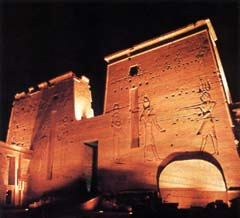Here the Nile is at its most beautiful, flowing through amber desert and granite rocks, round emerald islands covered in palm groves and tropical plants.
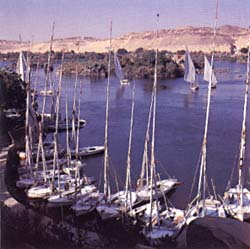
Aswan Cultural Center
Every night Nubian dancers and musicians perform in the Cultural Center, just off the Corniche. Folklore troupes recreate scenes from village life and perform the famous Nubian moch stick-fight dances.
| Not only the two temples at Abu Simbel among the most magnificent monument in the world but their removal and reconstruction was an historic event itself. When the temples (280 km from Aswan) where threatened by submersion in Lake Nasser, due to the construction of the High Dam, the Egyptian Government secured the support of UNESCO and |
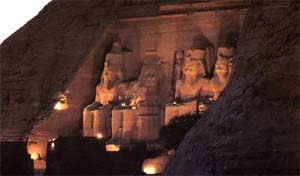 Abou Simbel |
|
| launched a world-wide appeal. During the salvage operation, which began in 1964 and continued until 1968, the two temples were dismantled and raised over 60m. up the sandstone cliff where they had been built more than 3,000 years before. | ||
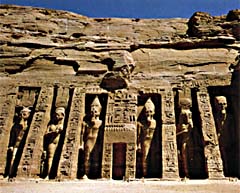 The temple of Nefertari |
The design
of Abu Simbel is unique, there is no other example of twin
sanctuaries, in this case dedicated to Ramses II himself and to his
wife Nefertari, which combine to form a single ensemble. Abu Simbel was recovered from the sand in 1817. The image of the main temple facade is well-known all over the world. You can still feel the full might of the pharaohs-god in this edifice dedicated to masculine prowess and military power and, equally, the love of his wife and children, symbolized in the flowers and femininity of the smaller temple. |
|
| This sun still shines directly on the Holiest of Holies two days a year: February 21, the king's birthday, and October 22, the date of his coronation. | ||
|
The Temple of Kalabsha |
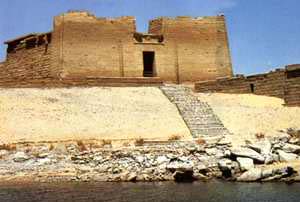 Kalabsha Temple |
| The Nile The Nile winds its way 6,500 kilometers from its origins in the Great African Lakes to the Mediterranean. Its sources were unknown until the 19th century. Today they have been identified in the Nyawarongo river, a tributary of another river which enters Lake Victoria. The Nile flows northwards across the immense Savannah with its woods and marshes before gathering into itself from the left the waters of the Bahr El Ghazzal (The Gazzle River) originating in the Darfour and Congo regions, and from the right the waters of the Sobat, the blue Nile (or Bahr El Azrak) and the Atbarah from the high plateaus |
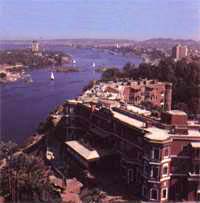 The city by the river |
|
| of
Abyssinia. It then runs up against the Limestone barrier of the
Sahara and its progress is interrupted by the cataracts as it flows
slowly towards the Mediterranean without receiving the waters of any
other tributary. Egypt proper is simply that northern part of this
great valley which extends from the cataracts at Aswan to the sea. From Aswan to the ruins of Thebes and Cairo it becomes considerably wider again. At El Manach the Nile divides into two: the Eastern part constitutes the principal branch which has more appearance of a winding lake than of a river, with its numerous islands and its banks lined with palm trees, acacia and sycamore trees, and fields of barley, wheat, alfalfa and broad beans. Shortly after the Nile leaves Cairo it loses sight of the mountains which up to then have followed its course. The Arabian and Libyan mountains get further apart and rise up respectively on the edge of the Red Sea and in the Mediterranean to the west of Alexandria. In the vast triangular plain of the Delta a multitude of canals link the Rachid or Rosette branch to the Damiette or Domiatte branch. As a result of periodic flooding Egypt has a particularly rich flora. There are many types of big trees, numerous species of acacia and sycamore, forests and palm trees and many aquatic plants including the Papyrus and the Lotus. This is why Herodotusís statement that ď Egypt is a gift of the NileĒ continues to be as true today as when he said it, in an ancient Egyptian document. |
||
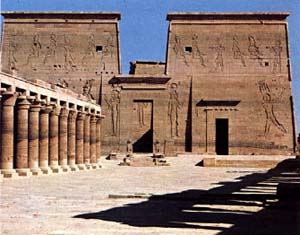 Philae Temple
|
Philae
temple was also dismantled and reassembled (on Agilika Island about 500m. from its original home on Philae island) in the wake of the High Dam. The temple, dedicated to the goddess Isis, is in a beautiful setting which has been landscaped to match its original site. Its various shrines and sanctuaries, which include a temple of Hathor, a Birth House and two pylons, celebrate all the deities involved in the Isis and Osiris myth.
At night visit the Sound and Light Show, a magical experience as floodlit buildings are silhouetted against the volcanic rocks and water surrounding them. |
Spectacular diving areas can also be found south of Sharm El Sheikh, along the Ras Muhammad Peninsula. Situated on the tip of Sinai Peninsula it divides the Red Sea into the Gulf of Suez and the Gulf of Aqaba (Eilat). Ras Muhammadís coral reef is known for its vast wealth of underwater flora and rare tropical fish and without doubt has one of the best diving sites. Sharks are also commonly found lurking around the water of Ras Muhammad.
(CAIRO - ALEXANDRIA - SHARM EL SHEIKH - FAYOUM - MERSA MATRUH - LUXOR - MINYA )
SYRIA - LEBANON - JORDAN
